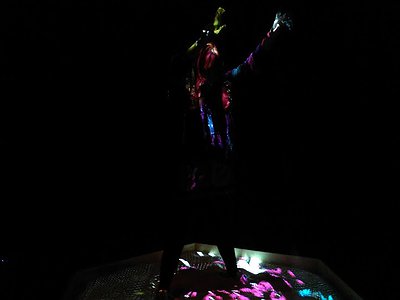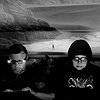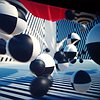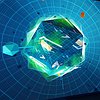Could you describe your creative process on the basis of a piece or series that's particularly dear to you? Where did the ideas come from, how were they transformed in your mind, what did you start with and how do you refine these beginnings into the finished work of art?
Kriss: It’s always a strange thing where you’re trying to solve a problem and you bash your head against it continuously for weeks or months and then one day, you wake up and you understand the solution. Once you’ve understood the solution and you really hope it’s the right solution, and there’s generally many days of trying to implement the solution and seeing if you’re right, and once you get to that point, what you’ve kinda got to is a thing that possibly hasn’t been done before. If you’ve hit a problem that blocks you and it’s something you can’t solve, you end up exploring a new space. So, after several weeks of hell, you get 5 minutes of fun where you just fiddle around with what you’ve got and see what it means and how it works - the reward is you get to be the first person to explore what you’re getting out of it.
For example, colour image remapping.
A break-down of how to choose a palette - that’s an interesting one - and it’s one that applies to art as much as anything else. Traditionally, there’s a 256 colour indexed palette. It’s how many colours you used to have in computer graphics back in the 80s and every pixel on the screen had to be one of those colours. When it comes to a true colour image, say a photograph, how you pick those 256 colours is actually a really hard problem and there’s a bunch of different solutions to how you do it. The sort of palettes that you get out of it in the end are completely different depending on the technology that you use. Recently, after about 20 or 30 years of worrying about the problem, it occurred to me a way of doing it which turned out to work. Instead of trying to come up with the palette, you constantly remap and you feed it back in on itself so all you’re doing is remapping the image rather than choosing the colours manually. That was a breakthrough in terms of the concept of how it works and at the end of the day, you get some very nice interesting colours out of images so it’s a different way of choosing important colours. I guess that’s the thing - it’s about picking which ones are most important to a person and trying to come up with an algorithm that matches how your brain would do it if you were to pick colours yourself. This was for “Swanky Paint”, a pixel art paint package that we are both currently working on during our spare time.
There are many descriptions of the ideal state of mind for being creative. What is it like for you? What supports this ideal state of mind and what are distractions? Are there strategies to enter into this state more easily?
Kriss: I don’t think there’s an easy way to get there - it’s just one of those things where you’ve got to put in the time. You’ve got to spend so many hours attempting to do something and eventually you get to that state. I’m not sure there is any particular shortcut or any way that you can magically start being creative - you’ve just got to sit down and start doing and keep going - no matter how hard it seems or how pointless or how horrible, you’ve just got to keep going and that’s how you eventually reach that state.
Shi: Distractions?
Kriss: I don’t mind distractions. Interruptions - I don’t like interruptions. There can be pink gorillas dancing around in front of me, that doesn’t bother me. But having to stop what I’m doing and go do something else - that’s an interruption and that’s a complete system failure.
Shi: Yes.
Do you tend to listen to the music in question a lot or at all while working on the project? Is your approach more guided by the emotions or ideas stirred by the music or conceptual considerations?
Kriss: Well, you have to listen to it - that’s how you do it. Yeah, you have to listen to what you’re using again and again and again to the point that you’re kind of sick of it. Certainly, all the times that I have an intense relationship with audio, I am incredibly sick of that audio by the time I get to the end of that project.
Shi: Definitely listen to it until you hear it in your sleep. Every single project we’ve done, I would consume the stuff we were working with until it permeates my subconscious. It seems to be the only way I can keep track of what I’m working on. I also tend to study the artist in question - watch and read interviews of them - go through their artistic history and see what sticks.
What kind of materials have proven to be particularly effective to work with? Do you maintain an archive of materials for potential use in future projects? If so, what does it consist of and what are your criteria for adding something to it?
Shi: I have a tonne of music books that I’ve saved from charity shops. I’m not trying to start a library but I’d be lying if I said I wasn’t. I play the scores to snap me out of a technical loop.
Kriss: I guess I kinda work in an ethereal state - I deal with things that are completely imaginary and have no physical substance. I have a favourite number generator, I suppose most people don’t have a set of favourite random numbers but I do, which is basically the random numbers that I first encountered on a Spectrum back in 1982. There’s 65536 of them and they always come one after the other and it visits each one of those numbers so every single one of those 65000 numbers is in the sequence somewhere and they’re just sort of jumbled up.
It’s a very simple mathematical formulae for which one comes next but I was always fascinated and obsessed by that sequence because it was the first one I came across as a kid.
n = n * 75 % 65537
Start with a number between 1 and 65536, inclusive.
Multiply the number by 75.
While the number is more than 65537, subtract 65537 to get the next number.
Otherwise, this is now the next number in the sequence.
You can start this whole process again for the next number in the sequence.
Read more here https://en.wikipedia.org/wiki/Lehmer_random_number_generator
Our sense of hearing shares intriguing connections to other senses.
From your experience, what are some of the most inspiring overlaps between different senses - and what do they tell us about the way our senses work? What happens to sound at its outermost borders?
Shi: Senses that trigger memories fascinate me. The process of olfaction, for some reason or other, plays a huge role in my every day. Strong smells, for example, can be very overwhelming to a violent degree but on the flip side, the same thing makes up for a wide range of interesting experiences like picking out nuances in incredibly bland food.
Kriss: I think all sensory inputs are connected to all other sensory inputs and you develop these connections between sound, smell, visuals - everything ends up being connected to everything else.
It’s like every font contains an echo of every word that was ever written in that font and advertised at you or shoved in your face and it’s the same thing with music - whatever you’re doing or experiencing when you’re listening to it - gets kinda jumbled up in your head and associated with the sounds.
Art can be a purpose in its own right, but it can also directly feed back into everyday life, take on a social and political role and lead to more engagement. Can you describe your approach to art and being an artist?
Kriss: I seek to confuse. As a general rule, it’s the zen-slap of awakening. Just doing the unexpected - surprising people, putting things together that shouldn’t go together but actually go together surprisingly well. It’s that attitude to art to intentionally try to snap people out of their complacency of whatever space they’re in and maybe just think about everything in a slightly different way. That’s all I ever seem to want to do or force people to experience - a switching of what they are into something else and just accept that there are other ways of looking at the world and everything is in your head.
Shi: It’s funny - people get confused when they see me doing the things I do. As a non-male person of colour, people usually assume that I’m Kriss’ personal assistant and not a collaborator of equal girth. When I was in my twenties, I did my fair share of graffiti activism but it was mostly an output of the oppression I felt back home (in Singapore) as a minority that was seen as a second-class citizen. Now I’m much older and slowly coming to accept that it’s ok to be a non-male person of colour and maybe explore some of that space in my own time. I do a monthly podcast about lesser known women composers (classical, jazz, contemporary) that I’m quite happy about - mostly as I also get to read and act out parts of scripts and narratives by lesser known women writers. The prose accompanies the music.
It is remarkable, in a way, that we have arrived in the 21st century with the basic concept of music design still intact. Do you have a vision of it, an idea of what it could be beyond its current form?
Shi: I’m excited by the maker movement; particularly those who create their own musical hardware. Designing and making your own synthesizer or theremin is immensely more satisfying than buying one - at least, that’s what I think. Not only do you get to learn how they work but at the same time, maybe improve or solve some of the problems current products in the market are facing, make them as strange or as dull as you like, see where it takes you. We’re currently in the process of creating a makerspace in the city we live in specifically for these reasons.
Kriss: There is the concept of the ‘light synth’ which is what Jeff Minter’s been on about for 30 or 40 years that I think is perhaps not appreciated as much as it should be. The idea of building a synthesizer for light, like creative coding but this takes a stranger route where you’re knob-twiddling in time to the music to produce different, interesting patterns and that’s not the same as being reactive to the music so much - you’re messing around with variables more than you’re typing stuff in.
Some links if you’re interested:
1. http://www.minotaurproject.co.uk/psychedelia.php
2. https://www.youtube.com/watch?v=L7UsnI_HQYM






